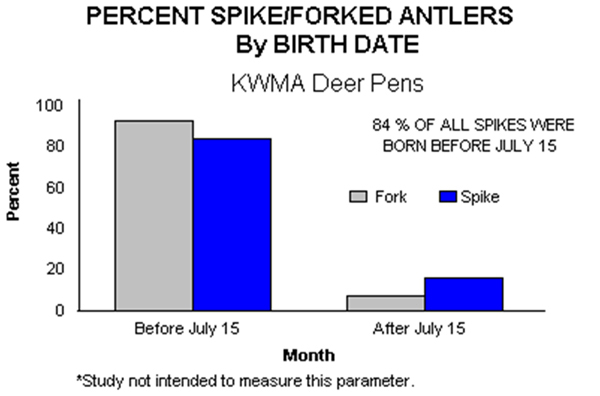Related Facts and Results
Age of Doe
Early in the deer facility studies, the effect of age of the dam (doe) and their influence on antler production came into question. No studies from the deer research facility were specifically designed to determine the effect of dam age on antler production. However, data from the facility showed that 73% of the spikes born were produced by 3-year-old or older deer. When age of doe is analyzed by study, only the study where spikes were bred back to their daughters did a large number of young does produce spike offspring. This was to be expected since bucks that were spikes as yearlings were bred to does sired by spikes.
Time of Birth
Some people have suggested that the timing of birth might influence antler quality. It was felt by some that fawns born in late August or September would be spikes just by virtue of their late birth date. This concern was not specifically addressed in a separate research project. However, based on data from the deer facility, over 80% of the spikes were born before July 15th. A 3 year, statewide study in Texas indicated that 95% of Texas deer are born before July 15th. Again, the only study to produce a significant number of spikes after July 15 was the study in which spike bucks were bred back to their daughters. This was to be expected.

Percent of spike/forked antlers by birth date chart.
Removal of a Cohort of Deer
Some biologists were concerned that removal of spike bucks would diminish a cohort of deer. The concern was that no yearling bucks would remain if all spikes were removed. A study of harvest data in the Edwards Plateau Region of Texas indicates that approximately 60% of the harvest of yearling deer are fork antlered. Removal of spikes and protection of the forked antlered cohort would insure more yearling deer would remain after harvest.
Role of the Doe
As far as we know, the doe carries 50% of the genetic material for antler development. In the deer research facility, some does consistently produce small antlered offspring and some consistently produced large antlered offspring. When spike-antlered males were bred to "spike-antlered" females, the offspring were often spikes at 1 and 2 years of age, with a few being spikes at 3 years. When females from forked-antlered sires were bred to fork-antlered males, the offspring were often large antlered.
Nutritional Spike vs Genetic Spike
There really is no such thing. All animals have a genetic potential that is influenced by its environment. Antler development is neither simply nutritional nor genetic. It is a combination of both. Therefore, a long spike is not necessarily a genetic spike, and a short spike is not a nutritional spike. Within a given year, on the same rangeland, a small spike likely has less potential than the long spike. To improve overall antler quality, theoretically both should be removed.
Presence or Absence of Brow Tines as a Predictor for Future Antler Characteristics
Many landowners and sportsmen have often questioned why some mature bucks (4.5 plus years old) do not have "brow tines." Since 1974, the Kerr Wildlife Management Area has been involved in a series of studies designed to determine the role of nutrition and/or genetics in antler development. We compared antler development based on presence of brow tines at 1, 2, 3 and 4 years of age. Antlers were collected from 1974 to 1997 from various studies. Antlers were categorized as to number of points on the basic frame: if no brow tines were present, if only one brow tine was present or if both brow tines were present. Data were analyzed based on the absence or presence of one or both "brow tines" and compared to antler weight (mass), body weight, antler points, antler basal circumference, antler spread, main beam length and gross Boone and Crockett score at 1.5, 3.5 and 4.5 years of age. We examined antlers from 217 deer (651 sets) for which at least the first three sets of antlers were available and 168 deer (672 sets) for which at least the first four sets of antlers were available. Results showed that 90% of the bucks without brow tines at 3.5 and 4.5 years of age were spikes as yearlings. All bucks with 5 or more points as yearlings had both brow tines at maturity. All bucks without brow tines at 4.5 years of age had none when they were yearlings. All yearling bucks that had both brow tines also had both brow tines at 3.5 and 4.5 years of age.
Effects of Early Weaning on Fawn Survival
The Effects of Early Weaning on Fawn Survival study was a two year project with two different fawn crops in which fawns were weaned at 60, 90 and 120 day intervals. Growth rates and other physical measurements were made to measure the effects and were compared to fawns which remained with their mothers. There was no difference in growth patterns between fawns weaned at 60 days and those that were left with their mothers. This data is published in Federal Aid Performance Report W-109-R Job 42: White-tailed Deer Growth and Development.